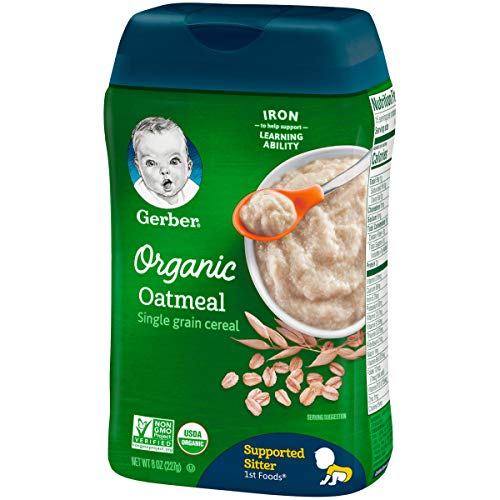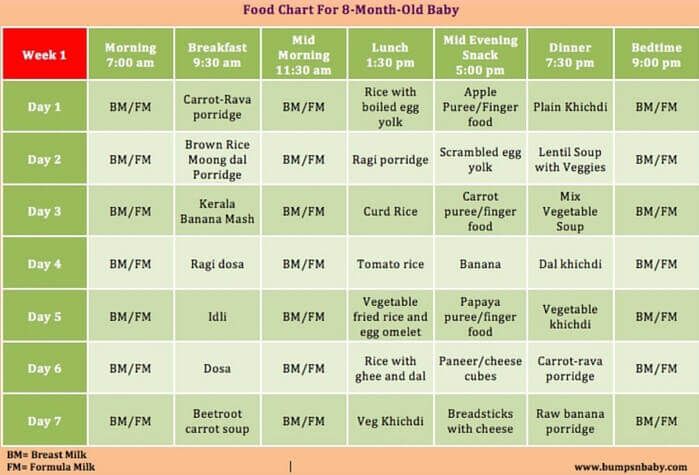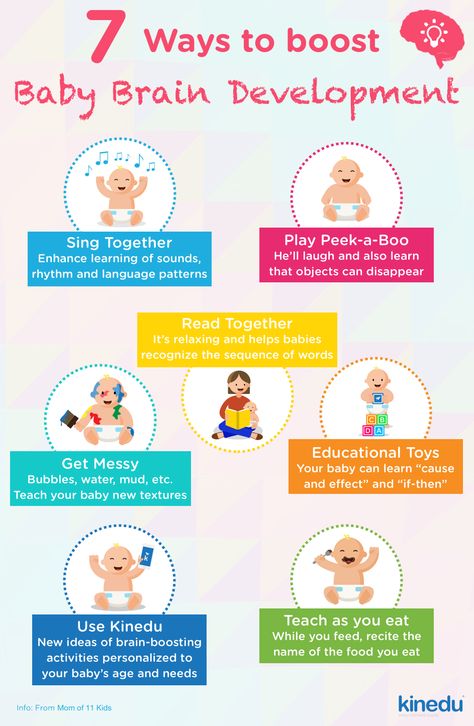Feeding baby formula schedule
Amount and Schedule of Baby Formula Feedings
- In the first week after birth, babies should be eating no more than about 1 to 2 ounces (30 to 60 ml) per feed.
- During the first month, babies gradually eat more until they take 3 to 4 ounces (90 to 120 ml) per feed, amounting to 32 ounces per day. Formula-fed babies typically feed on a more regular schedule, such as every 3 or 4 hours. Breastfed babies usually take smaller, more frequent feedings than formula-fed infants.
If your baby sleeps longer than 4 to 5 hours during the first few weeks after birth and starts missing feedings, wake them up and offer a bottle.
By the end of the first month: Your baby will be up to at least 3 to 4 ounces (120 mL) per feeding, with a fairly predictable schedule of feedings about every 3 to 4 hours.
By 6 months: Your baby will consume 6 to 8 ounces (180–240 mL) at each of 4 or 5 feedings in 24 hours.
Formula feeding based on body weight
On average, your baby should take in about 2½ ounces (75 mL) of infant formula a day for every pound (453 g) of body weight. But they probably will regulate their intake from day to day to meet their own specific needs, so let them tell you when they've had enough. If they become fidgety or easily distracted during a feeding, they're probably finished. If they drain the bottle and continues smacking their lips, they might still be hungry.
There are high and low limits, however. If your baby consistently seems to want more or less than this, discuss it with your pediatrician. Your baby should usually drink no more than an average of about 32 ounces (960 mL) of formula in 24 hours. Some babies have higher needs for sucking and may just want to suck on a pacifier after feeding.
On-demand feeding
Initially it is best to feed your formula-fed newborn a bottle on demand, or whenever they cry with hunger.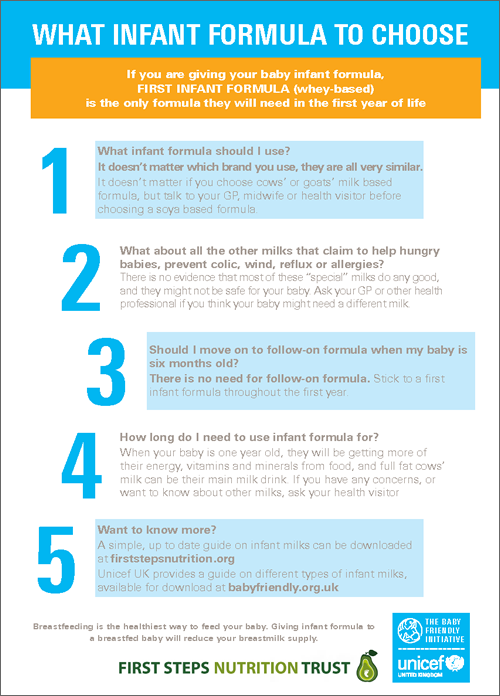 As time passes, your baby will begin to develop a fairly regular timetable of their own. As you become familiar with their signals and needs, you'll be able to schedule their feedings around their routine.
As time passes, your baby will begin to develop a fairly regular timetable of their own. As you become familiar with their signals and needs, you'll be able to schedule their feedings around their routine.
Eating & sleeping patterns
Between 2 and 4 months of age (or when the baby weighs more than 12 lb. [5.4 kg]), most formula-fed babies no longer need a middle-of-the-night feedings. They're consuming more during the day, and their sleeping patterns have become more regular (although this varies considerably from baby to baby). Their stomach capacity has increased, too, which means they may go longer between daytime feedings—occasionally up to 4 or 5 hours at a time.
If your baby still seems to feed very frequently or consume larger amounts, try distracting them with play or with a pacifier. Sometimes patterns of obesity begin during infancy, so it is important not to overfeed your baby.
Getting to know your baby's feeding needs
The most important thing to remember, whether you breastfeed or bottlefeed, is that your baby's feeding needs are unique. No book―or website―can tell you precisely how much or how often they need to be fed or exactly how you should handle them during feedings. You will discover these things for yourself as you and your baby get to know each other.
No book―or website―can tell you precisely how much or how often they need to be fed or exactly how you should handle them during feedings. You will discover these things for yourself as you and your baby get to know each other.
More information
- How Often and How Much Should Your Baby Eat?
- Making Sure Your Baby is Getting Enough Milk
- Is Your Baby Hungry or Full? Responsive Feeding Explained (Video)
- Remedies for Spitty Babies
- Last Updated
- 5/16/2022
- Source
- Adapted from Caring for Your Baby and Young Child: Birth to Age 5 7th Edition (Copyright © 2019 American Academy of Pediatrics)
The information contained on this Web site should not be used as a substitute for the medical care and advice of your pediatrician.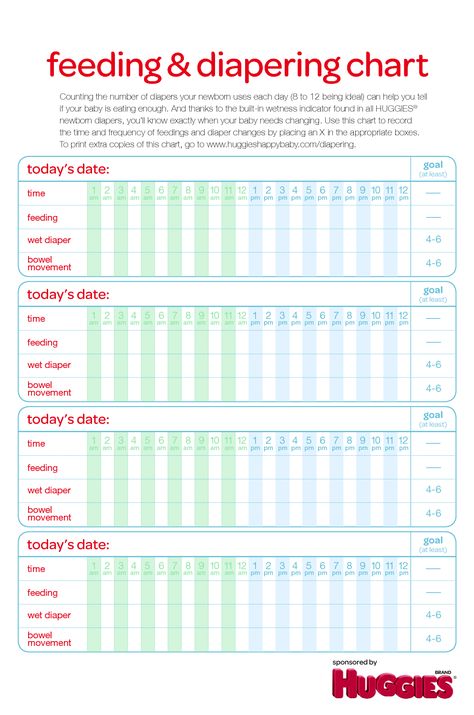 There may be variations in treatment that your pediatrician may recommend based on individual facts and circumstances.
There may be variations in treatment that your pediatrician may recommend based on individual facts and circumstances.
How Often and How Much Should Your Baby Eat?
By: Sanjeev Jain, MD, FAAP
One of the most common questions new parents have is how often their baby should eat. The best answer is surprisingly simple: in general, babies should be fed whenever they seem hungry.
How do I know when my baby is hungry?
For babies born
prematurely or with certain medical conditions, scheduled feedings advised by your pediatrician are best. But for most healthy, full-term infants, parents can look to their baby rather than the clock for hunger cues. This is called feeding on demand, or
responsive feeding.
Hunger cues
A hungry baby often will cry. But it's best to watch for hunger cues before the baby starts
crying, which is a late sign of hunger and can make it hard for them to settle down and eat.
Some other typical hunger cues in babies:
Licking lips
Sticking tongue out
Rooting (moving jaw and mouth or head in search of breast)
Putting his/her hand to mouth repeatedly
Opening her mouth
Fussiness
Sucking on everything around
It is important to realize, however, that every time your baby cries or sucks it is not necessarily because he or she is hungry. Babies suck not only for hunger, but also for comfort; it can be hard at first for parents to tell the difference. Sometimes, your baby just needs to be cuddled or changed.
General guidelines for baby feeding
It is important to remember all babies are different―some like to snack more often, and others drink more at one time and go longer between feedings. However, most babies will drink more and go longer between feedings as they get bigger and their tummies can hold more milk:
Most newborns eat every 2 to 3 hours, or 8 to 12 times every 24 hours.
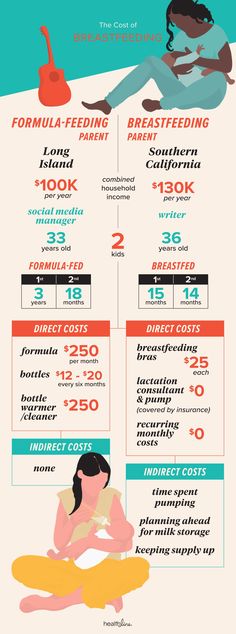 Babies might only take in half ounce per feeding for the first day or two of life, but after that will usually drink 1 to 2 ounces at each feeding. This amount increases to 2 to 3 ounces by 2 weeks of age.
Babies might only take in half ounce per feeding for the first day or two of life, but after that will usually drink 1 to 2 ounces at each feeding. This amount increases to 2 to 3 ounces by 2 weeks of age.At about 2 months of age, babies usually take 4 to 5 ounces per feeding every 3 to 4 hours.
At 4 months, babies usually take 4 to 6 ounces per feeding.
At 6 months, babies may be taking up to 8 ounces every 4 to 5 hours.
Most babies will increase the amount of formula they drink by an average of 1 ounce each month before leveling off at about 7 to 8 ounces per feeding. Solid foods should be started at about 6 months old.
Concerns about overfeeding or underfeeding your baby
Too full?
Babies are usually pretty good at eating the right amount, but they can sometimes take in more than they need. Infants who are
bottle feeding may be more likely to overfeed, because drinking from a bottle may take less effort than
breastfeeding.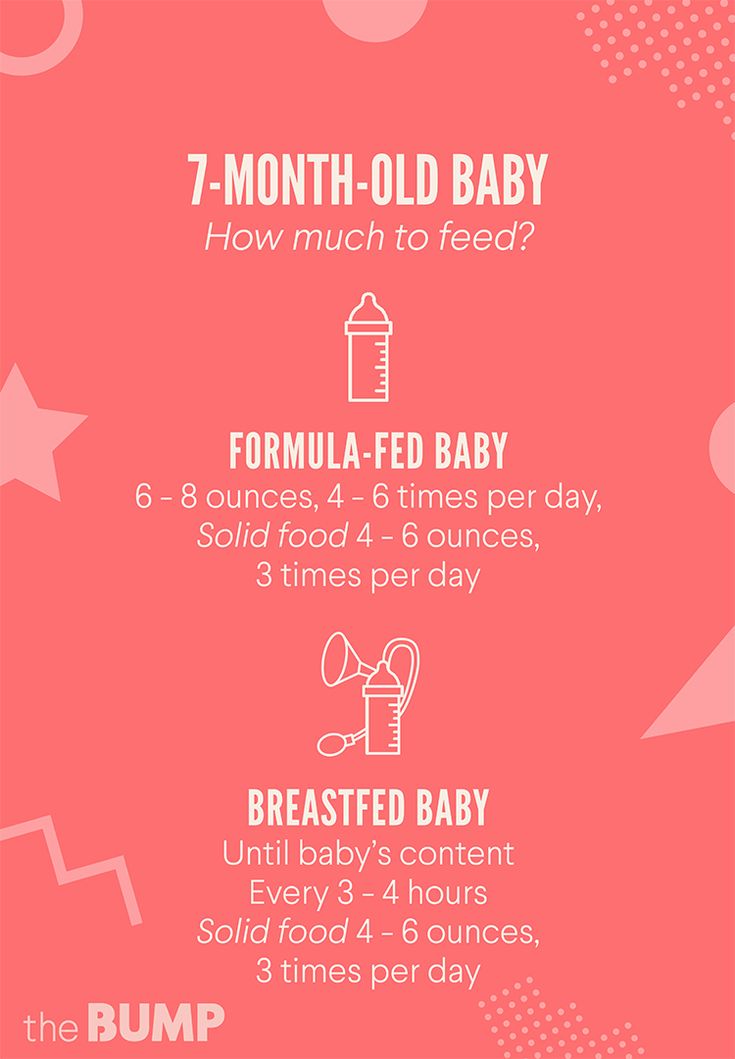
Overfed babies can have stomach pains, gas, spit up or vomit and be at higher risk for obesity later in life. It's better to offer less, since you can always give more if your baby wants it. This also gives babies time to realize when they're full.
If you are concerned your baby wants to eat all the time―even when he or she is full―talk with your pediatrician. Pacifiers may be used after feeding to help sooth healthy-weight babies who like to suck for comfort, rather than nutrition. For babies who are breastfed, it's best to wait to offer pacifiers until around 3 to 4 weeks of age, when breastfeeding is well-established.
Trouble gaining weight?
Most babies will double their birth weight by 5 months of age and triple their birth weight by their first birthday. If your baby is having trouble gaining weight, don't wait too long between feeding―even if it means waking your baby. Be sure to talk with your pediatrician about how often and how much to feed your baby.
How do I know if my baby is getting enough to eat?
Daily diapers
A newborn's diaper is a good indicator of whether he or she is getting enough to eat. In the first few days after birth, a baby should have 2 to 3 wet diapers each day. After the first 4 to 5 days, a baby should have at least 5 to 6 wet diapers a day. Stool frequency is more variable and depends whether your baby is breastfed or formula fed.
Growth charts
During regular health check-ups, your pediatrician will check your baby's weight and plot it on a growth chart. Your baby's progress on the growth chart is one way to tell whether or not they are getting enough food. Babies who stay in healthy growth percentile ranges are probably getting a healthy amount of food during feedings.
Remember
Talk with your pediatrician if you have any questions or concerns about your baby getting the right amount to eat.
More information:
- Making Sure Your Baby is Getting Enough Milk
- Amount and Schedule of Formula Feedings
- Is Your Baby Hungry or Full? Responsive Feeding Explained (Video)
- Remedies for Spitty Babies
- Ask the Pediatrician: With the baby formula shortage, what should I do if I can't find any?
- Ask the Pediatrician: How should we feed our baby if we're running low on money?
-
Airplane Choo Choo: A Feeding Guide for Children (National Dairy Council)
About Dr.
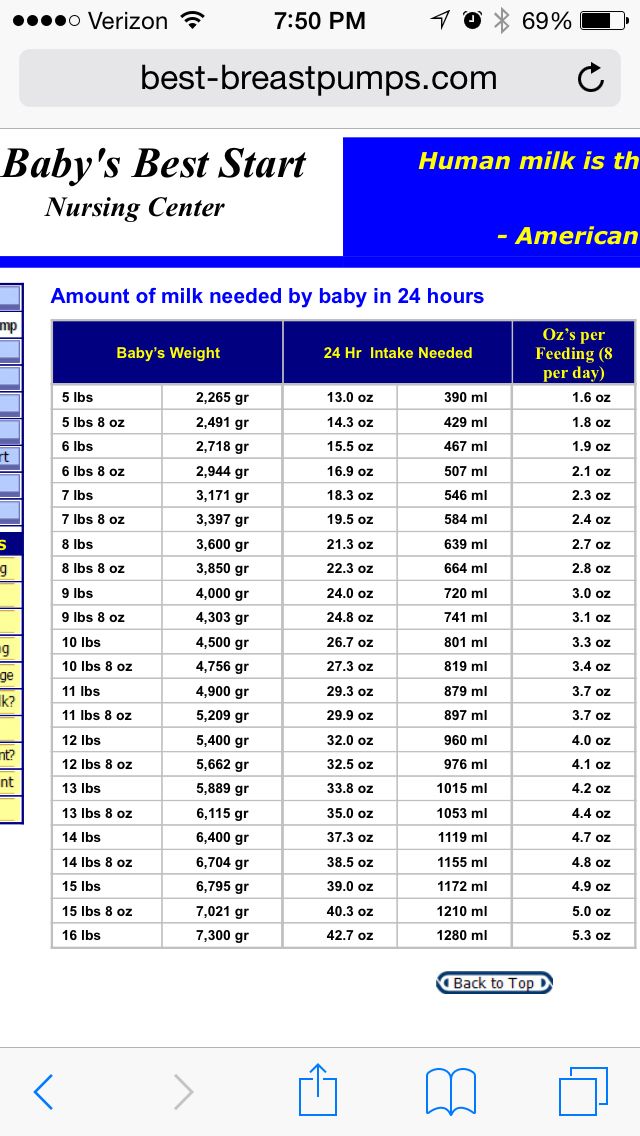 Jain:
Jain:
Sanjeev Jain, MD, FAAP, is a Clinical Associate Professor of General Pediatrics and Adolescent Medicine at the University of Wisconsin School of Medicine and Public Health. Within the American Academy of Pediatrics, he is a member of the Section on International Child Health and the Wisconsin State Chapter.
The information contained on this Web site should not be used as a substitute for the medical care and advice of your pediatrician. There may be variations in treatment that your pediatrician may recommend based on individual facts and circumstances.
table of the introduction of the first complementary foods by months, input scheme, the correct menu of the child on the IV, what can be given to the artificial
Contents: Hide
Formula-fed complementary foods
Inexperienced mothers of newborn babies are concerned about many problems: fighting colic, establishing a daily routine, performing hygiene procedures. However, time goes by and acute issues gradually become irrelevant. Inexorably, a new crucial stage is coming - the introduction of the first complementary foods begins. We will tell you how to properly introduce complementary foods with artificial feeding.
However, time goes by and acute issues gradually become irrelevant. Inexorably, a new crucial stage is coming - the introduction of the first complementary foods begins. We will tell you how to properly introduce complementary foods with artificial feeding.
Why does a baby need complementary foods
Both natural and bottle-fed babies are usually equally full of energy, active and inquisitive. The introduction of complementary foods allows you to gradually accustom the baby's gastrointestinal tract to new food, as well as give the growing body the vitamins and minerals that it needs at a particular stage of physical development. Also, with its help, you can gradually adapt the baby to the diet of adult family members and then painlessly transfer it to the common table. There are no exact norms and rules for the introduction of complementary foods. It is necessary to focus on the needs of the child and follow the recommendations of the pediatrician.
When can complementary foods be introduced with artificial feeding
Teaching children to adult food should be timely. The fact is that the gastrointestinal tract of an infant at a too early age (for example, 2-3 months) is not able to process certain foods. The mucous membrane of the digestive system is irritated, and this can provoke gastritis and other serious health problems.
The fact is that the gastrointestinal tract of an infant at a too early age (for example, 2-3 months) is not able to process certain foods. The mucous membrane of the digestive system is irritated, and this can provoke gastritis and other serious health problems.
IMPORTANT! At what age can you introduce your baby to new products? For children in good health, WHO recommends that complementary foods be introduced at 6 months of age. But for some babies, if there are certain medical indications, the doctor may advise you to do this earlier.
The recommendations do not provide a specific menu for each age, which must be followed. Much depends on the socio-cultural characteristics of different peoples and the individual pace of development of children. In most cases, the timing of the start of complementary foods varies from 4.5 to 6 months. Specialists distinguish the following signs of a child's readiness to try something new, in addition to the usual artificial mixture:
• the baby is not quite full of the mixture and asks to continue the meal;
• his first teeth have already erupted, he tries to chew them, takes and tries to taste food from adult plates;
• if you bring a spoon to the baby, he will begin to examine its contents and want to try it;
• the child sits confidently, can turn his head and control his body;
• The tongue thrust reflex fades so baby can drink water from a spoon without it dripping back out.
It is not necessary that all of the listed features be present at once. If several of them are observed, then it is quite possible to try to introduce the first complementary foods.
Read also: How much does a newborn eat per feeding?
When to delay feeding
It is better to delay feeding if:
• the child is ill;
• less than three days have passed since vaccination;
• the baby is teething, he does not sleep well and is naughty;
• there have been some changes in the family's lifestyle, such as moving to a new home, mother going to work, traveling to another city or country;
• the crumbs have manifestations of allergies, upset of the gastrointestinal tract;
• The weather is too hot outside.
Therefore, complementary foods should only be offered to a child when he is completely healthy, calm and in a good mood.
Basic rules for the introduction of complementary foods
Anna Levadnaya, pediatrician, Candidate of Medical Sciences, explains that the principles of introducing complementary foods on natural and artificial feeding are similar: it is recommended to focus on food interest, signs of a child's readiness for introducing complementary foods. The only thing is that with exclusive breastfeeding, it is not recommended to supplement the child with water, while bottle-fed children can be offered water.
The only thing is that with exclusive breastfeeding, it is not recommended to supplement the child with water, while bottle-fed children can be offered water.
Video: 10 rules for complementary foods
Author: pediatrician, Ph.D. Komarovsky E.O.
The rest of the principle is the same: for both breastfeeding and formula-feeding, offer your baby a new food before feeding, and then supplement with breast milk or formula.
In order for new products to bring benefits to the baby on artificial feeding and not harm his health, you should follow a number of simple recommendations.
1. Complementary foods are usually given in the morning before the main formula feeding. This allows you to track the reaction to unfamiliar food during the day and take action if necessary.
2. It is necessary to carefully monitor the cleanliness of children's dishes, pots and blenders. The gastrointestinal tract of an infant is very sensitive to infectious agents.
It is necessary to carefully monitor the cleanliness of children's dishes, pots and blenders. The gastrointestinal tract of an infant is very sensitive to infectious agents.
3. New food is introduced into the baby's diet from a quarter of a teaspoon. If he tolerated the product well, then within a week the portion is brought to one or two tablespoons. Then you should look at the desire of the child and his well-being, and also take into account the recommendations of the pediatrician.
4. The first dishes should be of a liquid consistency, then they are made into a puree, and only closer to a year can you give soft pieces to chew. Pediatricians advise adding butter and vegetable oils to them as vegetables and cereals are introduced into the diet.
5. In order to protect the child's body from pathogens that may be contained in unprocessed food, complementary foods should first be boiled, stewed or baked. The baby is offered slightly warm food: the optimum temperature is 36-37 degrees.
6. It is advisable to try the products immediately from a spoon. If the baby gets used to the bottle, this will slow down the formation of the skill of chewing food and may subsequently affect diction.
7. A food diary can help you reliably identify what your child has an allergic reaction to. It should record everything that the baby ate during the day, in what quantity and at what time. You can also record in a diary whether he liked the new dish or not.
8. Complementary foods should be introduced only from mono-products. Only after making sure that vegetables, cereals, juices, fruits or protein products are well tolerated by the child, you can offer their mixes.
9. The interval between introduced and new complementary foods should be at least a week. Such a period of time will allow the child's body to adapt to the expanded diet and perceive other dishes without unpleasant surprises.
10. If an allergy occurs to any product, it should be immediately removed from the menu and consulted by a pediatrician. It will be possible to return to this complementary food no earlier than in a month.
It will be possible to return to this complementary food no earlier than in a month.
11. It is desirable that with the introduction of complementary foods, the infant receives a sufficient amount of liquid. It can be both ordinary water and compotes.
12. Do not offer your child foods that are considered highly allergenic as first foods: full-fat cow's milk, citrus fruits, gluten-containing cereals, chicken eggs, etc.
13. Do not force-feed a child, even if you think that he is hungry. A small person has the right to defend his opinion in the choice of dishes.
14. Feed your baby exclusively in a sitting or reclining position to avoid the risk of aspiration. Very convenient for this purpose are special highchairs made of easy-to-clean material.
From 7–8 months, formula-fed mashed or pureed food, such as a banana, can be used as complementary foods. If semi-solid food is not introduced into his diet in time, problems may arise with the intake of solid food in the future: after a year, the child will refuse it completely.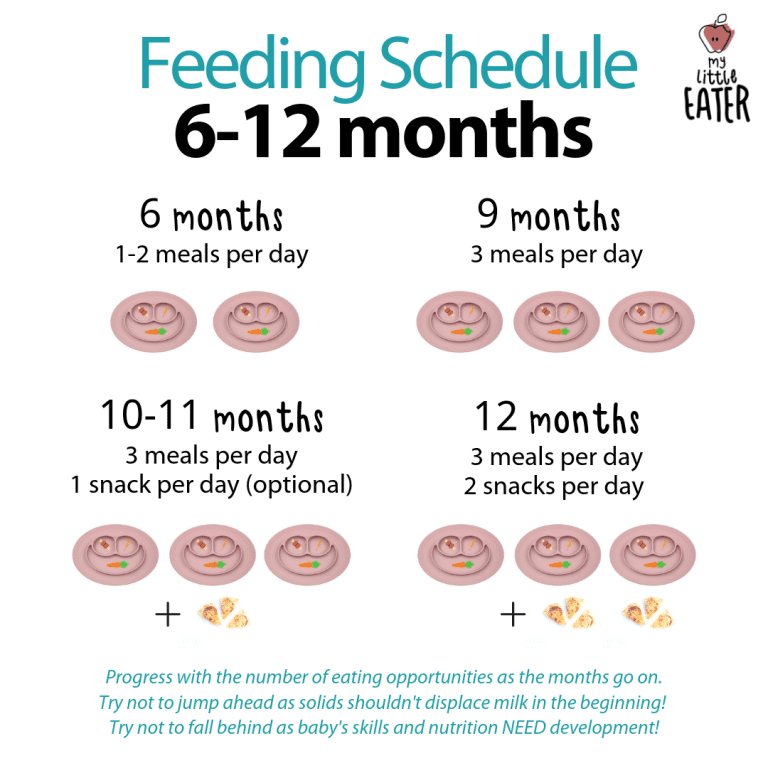 From 8–9 months, the child should be offered the so-called finger food: cut soft fruits and vegetables into pieces, such as boiled carrots, potatoes, and offer them to the baby. If you follow this scheme, by the year the child will be ready to eat solid food from the common table, Levadnaya explains.
From 8–9 months, the child should be offered the so-called finger food: cut soft fruits and vegetables into pieces, such as boiled carrots, potatoes, and offer them to the baby. If you follow this scheme, by the year the child will be ready to eat solid food from the common table, Levadnaya explains.
Complementary Feeding Schedule
We provide a suggested complementary feeding schedule for up to a year to guide you unless advised otherwise by your doctor. As a standard formula-fed babies with normal weight gain are offered products in approximately the following order:
• vegetable puree;
• cereals;
• fruit puree;
• kefir;
• butter and vegetable oil;
• children's biscuits and bread;
• meat puree;
• fish puree.
The earlier introduction of vegetable puree rather than fruit puree is due to the fact that the former has a more insipid taste. Having fallen in love with sweet apples and bananas, the child may subsequently refuse to eat zucchini, pumpkin, etc.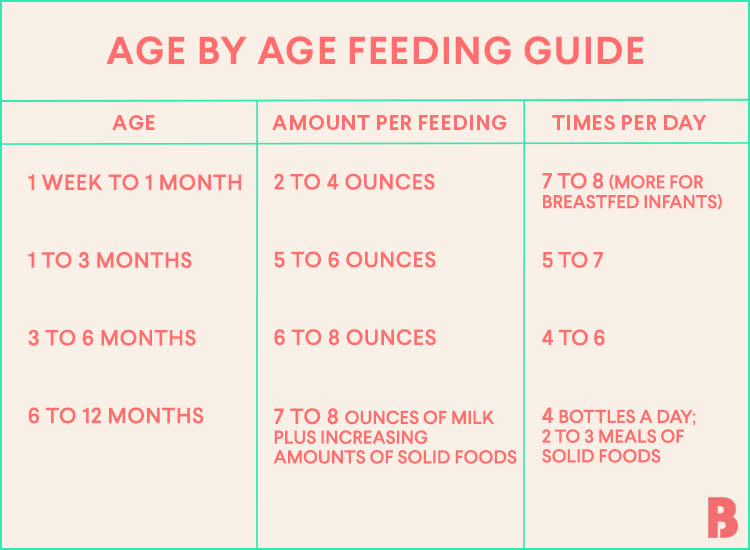 However, if the infant is underweight, the doctor may recommend porridge as the first complementary food for him. They are more high-calorie and allow you to gain the missing kilograms faster. Each type of complementary food is described in the table.
However, if the infant is underweight, the doctor may recommend porridge as the first complementary food for him. They are more high-calorie and allow you to gain the missing kilograms faster. Each type of complementary food is described in the table.
| Vegetables | They are usually offered to children in the following order:
Tomatoes, white cabbage and cucumbers are recommended to be included in the menu already after a year. |
| Fruit | Seasonal fruits are recommended. The approximate order of their introduction: apples, pears, peaches, apricots and bananas. If the baby suffers from constipation, you can carefully and with the permission of the pediatrician offer him plums. |
| Kashi | To start complementary foods, choose gluten-free cereals: buckwheat, rice, corn grits. After the child is 8 months old, you can gradually give him a taste of oatmeal, wheat and barley porridge. It is better to refuse semolina altogether, since it contains very few useful substances and at the same time it is very high in calories. Cereals can be ground in a coffee grinder or mashed from ready-made cereals in a blender. |
| Protein products | Fermented milk products do not need to be introduced earlier than 8 months, since only by this time do children begin to produce the enzymes necessary for their processing. From meat, children under one year old should be given rabbit, chicken, turkey and veal. Sea fish is more suitable - hake, cod or flounder. Meat and fish are offered to kids in grated form as part of vegetable dishes and cereals. Cottage cheese can be prepared for the baby yourself. |
IMPORTANT! It is undesirable to add salt, sugar and spices to food for a child. His taste buds are not yet accustomed to strong stimuli, so it is better for him to appreciate the natural taste of the food offered. Soup should be cooked only on vegetable broths, and meat should be added to an already prepared dish. Meat broth may be too heavy for the baby's kidneys.
How to choose complementary foods
The main recommendations for choosing specific foods to start complementary foods are as follows:
1. It is recommended that your baby's diet be based on products grown in the region where he/she lives. If the period of the first feeding falls on the winter, it is advisable to stock up vegetables, fruits and berries from your garden in advance, putting them in the freezer for safekeeping.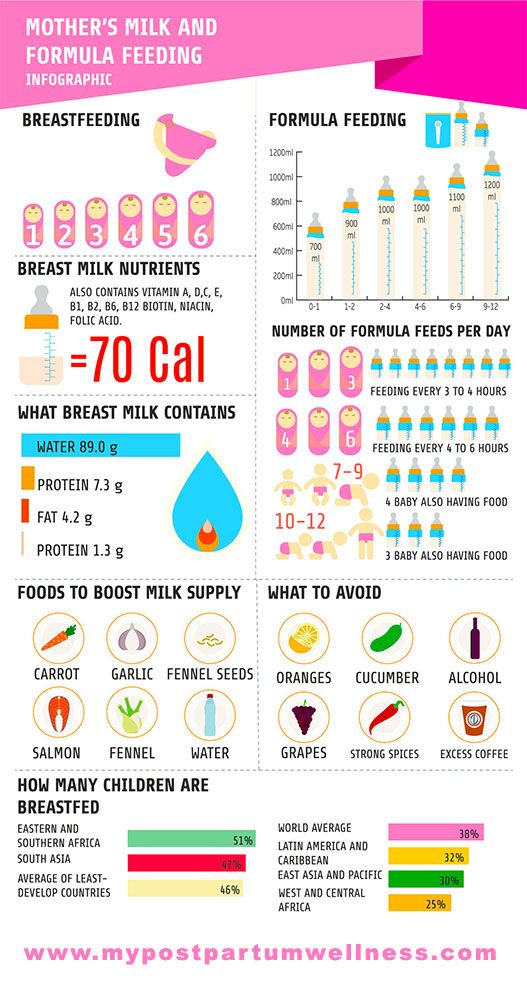 In the event that this is not possible, you can give preference to ready-made canned mashed potatoes. They undergo mandatory certification confirming the quality.
In the event that this is not possible, you can give preference to ready-made canned mashed potatoes. They undergo mandatory certification confirming the quality.
2. It is advisable not to buy store-bought juices for your child in large quantities. Compotes will be much more useful for him. You can also offer decoctions of dried fruits.
3. If you decide to buy ready-made food for your baby, then pay attention to the label and the release date. The product must be age appropriate and fresh. The composition should not contain salt, sucrose, dextrose and other extraneous additives.
In general, it is worth remembering that the first food offered to a child should be puree-like, not too viscous products, consisting of one ingredient, soft consistency, without added sugar, salt and spices, says Andrey Mosov, head of the expert direction of NP Roskontrol, doctor on nutritional hygiene of children and adolescents. He insists that preference should be given to industrial prepared meals, as such products have been tested and certified. There are no guarantees with mashed homemade vegetables.
There are no guarantees with mashed homemade vegetables.
Introduction of complementary foods to formula-fed premature babies
The question of the correct introduction of complementary foods to a premature baby should be discussed individually at a pediatrician's appointment. In order for the body to be able to process a new product, organs and systems must be sufficiently mature and prepared. The quality of food digestion largely depends on the production of special enzymes, so you should not be self-motivated in compiling the baby's menu.
The schedule for the introduction of complementary foods will be determined by the presence or absence of anemia, the rate of weight gain, the tendency to allergies, and some other nuances. Formula-fed premature babies are usually advised to start introducing meat and egg yolk earlier. It is advisable to cook porridge on a vegetable broth or mixture, and not on water, since then they will be more nutritious and healthy.
IMPORTANT! However, the course of complementary foods must be monitored by a pediatrician. The doctor monitors the child's reaction to new products, evaluates the dynamics of growth and general physical development. The scheme may change if any deviations from the norm are detected during routine inspections.
Answers to frequently asked questions for mothers
• What foods should not be given to babies under one year old?
It is forbidden to give cow's milk to babies under the age of one, as it can cause allergic reactions and digestive disorders. It is perfectly replaced by adapted mixtures from modern manufacturers. In addition to milk, it is not recommended to include nuts, citrus fruits, exotic fruits and vegetables, red fish and honey in the menu of the crumbs of the first year of life.
• What should I do if my child absolutely does not want to eat complementary foods?
Wait a while and try to offer food again, but don't insist on another refusal. Perhaps the baby did not like the new dish because of the unfamiliar taste. Children are big conservatives and are often wary of change. Be patient, do not rush to introduce complementary foods. Show your child with what appetite you yourself eat from your plate, and then he may have a desire.
Perhaps the baby did not like the new dish because of the unfamiliar taste. Children are big conservatives and are often wary of change. Be patient, do not rush to introduce complementary foods. Show your child with what appetite you yourself eat from your plate, and then he may have a desire.
• What should I do if my baby has problems with stool while weaning?
If a child has a stool retention of more than three days during the introduction of complementary foods, then we can talk about constipation. In this case, you need to visit a pediatrician, as well as immediately exclude fixing foods from the menu and give more fluids to drink. If the stool has become too frequent (more than 5 times a day), then this may be due to indigestion or an intestinal infection. Be sure to consult your doctor about this.
• What should I do if I have an allergy to complementary foods?
It is advisable to take care of this issue even before the introduction of complementary foods, asking the pediatrician observing the child to prescribe an antihistamine drug that is optimal for his age. You should also carefully fill out the food diary at first. With it, it will be possible to identify a possible allergen and exclude it from the baby's menu, preventing more serious health consequences.
You should also carefully fill out the food diary at first. With it, it will be possible to identify a possible allergen and exclude it from the baby's menu, preventing more serious health consequences.
• How do you know if a baby tolerates complementary foods well?
Normal weight and height gain, regular bowel movements, and the absence of allergic skin rashes indicate the successful introduction of complementary foods. If the baby is cheerful, active, he has a good appetite and a good sleep, most likely, this means that you are doing everything right and the selected diet suits him.
However, it is impossible to completely refuse artificial formula when introducing complementary foods, even when the infant eats complementary foods with appetite. His body is not yet ready for a complete change in the type of food and may malfunction. This often manifests itself in the form of allergies, stool disorders or growth retardation. Remember that the baby should enjoy the new food.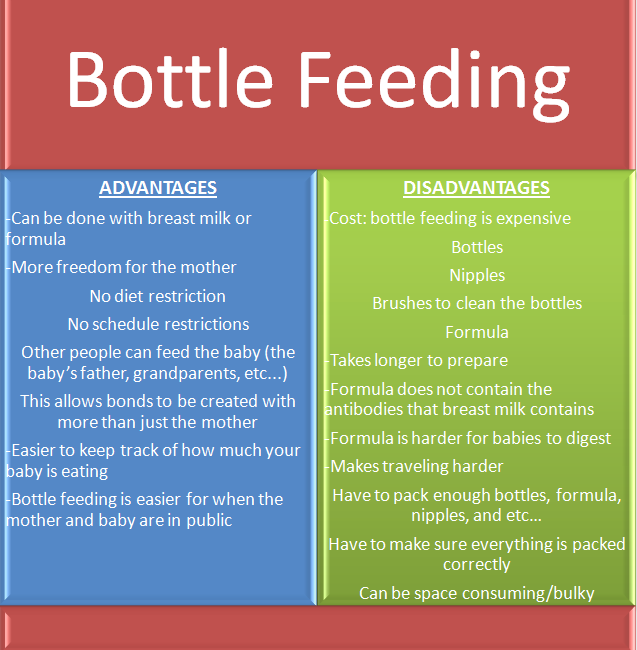 Only under this condition will he form the correct eating behavior.
Only under this condition will he form the correct eating behavior.
#Nutrition for children up to a year #Complementary food
Scheme of the first feeding of a child (table) with artificial and breastfeeding, what can be given to a baby
The need for the introduction of complementary foods in modern mothers has long been beyond doubt. Pediatricians, pediatric nutritionists and other graduates unanimously say that at some point both mother's milk and formula are not enough to satisfy the growing needs of the child's body for useful trace elements and vitamins. That's when it's time to introduce complementary foods. The fact that your baby is ready to get new experiences and try tastes so far unknown to him is indicated by the presence of the following signs:
• doubling the initial weight of the child,
• ability to sit with support,
• child does not push food out of his mouth,
• curiosity and desire to try something from the common table.
Signs of malnutrition in a child, constant feeling of hunger and anxiety associated with it, weight loss can also be important signals for the start of complementary foods. In these cases, it is recommended to immediately contact a specialist and share your observations with him.
Contents: Hide
- When to start the introduction of complementary foods
- with which products to start the introduction of complementary foods
- We avoid errors
- Table of complementary foods for months with artificial feeding
- Table of complementary foods for months during breastfeeding ,
- how to introduce complementary foods by
when
start introducing complementary foods
The timing of the introduction of complementary foods is still debated. But if we bring scientific reasoning to a common denominator, then the conclusion suggests itself that complementary foods can be introduced from about six months, and for children with certain medical indications - from 3-5 months. Many experts believe that half a year is the ideal time for complementary foods, when the first colic is over, and the digestive system has matured enough to try new foods. The exact answer to the question of when to introduce complementary foods in a particular child can only be given by a pediatrician. In some situations, it may be necessary to introduce new dishes into the baby's diet as early as 4 months, and someone will be ready for this only after six months.
Many experts believe that half a year is the ideal time for complementary foods, when the first colic is over, and the digestive system has matured enough to try new foods. The exact answer to the question of when to introduce complementary foods in a particular child can only be given by a pediatrician. In some situations, it may be necessary to introduce new dishes into the baby's diet as early as 4 months, and someone will be ready for this only after six months.
What foods to start complementary foods with
Fruits, vegetables or cereals? Which of these foods are best for starting complementary foods? Experts have long answered this question as follows: if the baby is underweight, suffers from frequent loose stools, it is advisable to start with cereals (of course, gluten-free and dairy-free), and if everything is fine with weight, then vegetables will be the first in line. Also, vegetable complementary foods are recommended for breastfed children with constipation problems, rickets, or those born prematurely, whose weight is normal or exceeds the standards.
Why not fruits? Everything is simple. Fruits have a bright and sweet taste, and after trying an apple or banana first, the baby is likely to refuse zucchini or broccoli, which do not have the same rich taste. Therefore, the introduction of fruit purees and juices into the diet is postponed until vegetable purees become a familiar dish on the menu. As for cereals, buckwheat, rice and corn are first introduced, as they are characterized by the absence of gluten, saturate and are well digested.
Read also: How to properly teach a child to different tastes
Avoiding mistakes
In order for the introduction of complementary foods not to become a test for either the baby or the mother, you need to follow some recommendations. Most importantly, be patient and don't get too upset if things don't go according to plan. Each child is individual, as are their taste preferences and needs.
• Start complementary foods if the baby is perfectly healthy. Contraindications for the introduction of new products will be teething, colds, stress associated with separation or moving, recent or planned vaccinations.
• New foods are introduced gradually, starting with half a teaspoon. In the absence of allergies or digestive problems, the amount of the product is approximately doubled the next day. Sometimes the introduction of a new product stretches up to a week. Do not rush, give the child the opportunity to "taste" this dish. If the baby flatly refuses the offer, postpone the acquaintance for at least a week.
• Do not force your child to eat. After all, your goal is to introduce your child to new tastes and help develop good eating habits.
• The best time for the first feeding is after the morning feeding until 12 noon, when the baby is already hungry and ready to eat something else. In case something goes wrong, you will know about it during the day, not at night.
• In the event of an adverse reaction to the product, such as an allergy, seek medical advice immediately. Then, in agreement with the doctor, offer this dish after a certain period of time.
• Gradually increase the amount recommended by your pediatrician.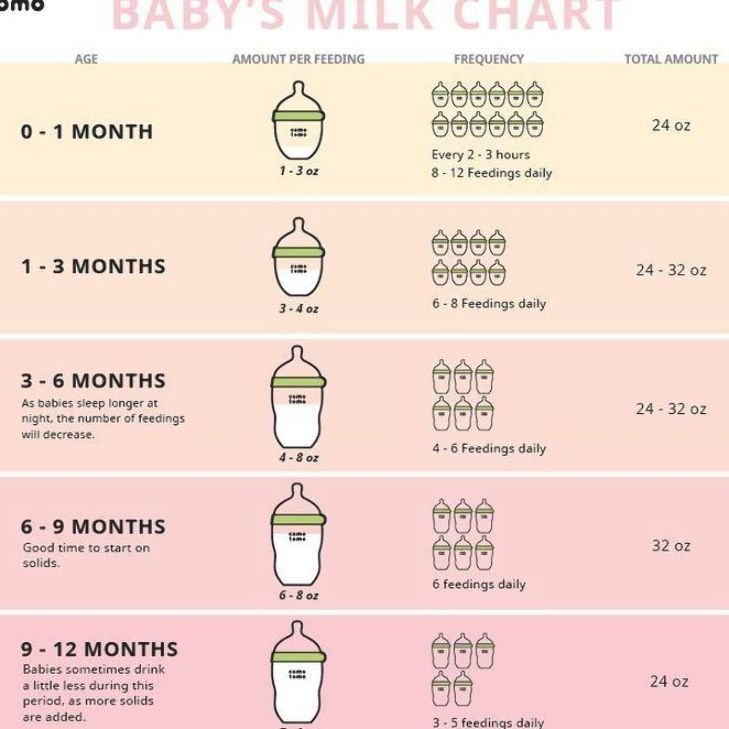 If you don't fit within a week, don't worry. Listen to your child and act accordingly.
If you don't fit within a week, don't worry. Listen to your child and act accordingly.
• Always start feeding with complementary foods. Only then offer breast milk or formula.
• Stick to a 5-meal schedule. Feed your baby at the same time every day.
• Food offered to the baby must be thermally processed - boiled or steamed. The dish should be at a comfortable temperature - about 37 ° C.
• Purees and cereals should be of a liquid consistency so that a child who does not yet know how to chew can comfortably eat them. Thicker dishes with lumps and pieces are introduced into the diet by about a year, when there are already several teeth.
• Do not use salt, sugar or spices when preparing complementary foods. Also, do not add them in order to force the child to eat something. Let the baby get used to natural tastes.
• Complementary foods are prepared at one time and should never be refrigerated until the next meal. Everything should be only the first freshness.
• If you prefer ready-made baby food, carefully study the top manufacturers, pay special attention to the shelf life when buying.
When introducing complementary foods, be guided by the data in the tables, which indicate which products, in what quantity and in what months experts recommend giving. 6 months
7 months
8 months
9 months
10 months
11 months
12 months
Vegetables
150 g
170 g
180 g
180 g
200 g
200 g
Porridge
50–100 g
180 g
180 g
180 g
200 g
200 g
FROTE
60 g
70 g
80 g
100 g
100 g
100 g
meat
50 g
60 g
| 70 g | 70 g | |||||||||||||||||||
| Come |
| 9000 9000 9000 9000 9000 9000 9000 | 10-30 g | 30 g | 40 g | 50 g | 50 g | |||||||||||||
|
|
| 1/4 | 1/4 | 1/2 | 1/2 | 9012U0315 1/2 |||||||||||||||
| Fish |
|
|
| 9000 | 90AM | 90AR0315 30 g | 50 g | |||||||||||||
| Vegetable oil |
|
| 3-5 ml | 5 ml | 5 ml | 5 ml | ||||||||||||||
| Oil. |
|
| 1 ml | 3-5 ml | 5 ml | 5 ml |
90URE
90AM0004 | 8 months | 9 months | 10 months | 11 months | 12 months | ||||||||
| Silent porridge | 10–150 g | 150–180 g | 9012U0123 200 g | 200 g | ||||||||||||||||
| 10–120 g | 90–120 G. 0128 0128 | 150 g | 170 g | 180 g | 200 g | 200 g | ||||||||||||||
| 90AL0005 | - | - | - | - | - | - 9 9000 9 | 160–200 ml | |||||||||||||
| Fruits | 5-60 g | 50-60 g | 60 g 9000 g 9000 g 9000 g 9000 g 9000 g 9000 g 9000 g 9000 g 9000 g 9000 g 9000 g 9000 g 9000 g 9000 g 9000 g 9000 g 005 | 100–120 g | 100–120 g | 100–120 g | ||||||||||||||
| meat | - 9000 - 9000 - 9000 - 9000 - 9,00050315 - | 10–30 г | 30–70 г | 60–70 г | 60–70 г | 80 г | ||||||||||||||
| cottage cheese | - | - | 5–10 g | 10-30 g | 40 g 9000 | 9012U0315 40 g 50 g | ||||||||||||||
| Yolk | - | - | ½ | ½ | ½ --1 | |||||||||||||||
| Fish | - | 9 - - | - | 10–40 g | 10–40 g | 50–60 G 9000 9000 3 912 91313 91313 9013Vegetable oil | - | - | 1 ml | 3-5 ml | 5 ml 9000 | 90AL0315 5 ml | 5 ml | |||||||
| Cream oil | - | 9000 1-3 g 9000,000,000,000,0005000 9000 9000 9000 315 3-4 g | 5 g | 5 g | 5 g |
, as you can see, the schemes for the introduction of complementary foods during thoracic and artificial feedback are not too much. In any case, starting to introduce new foods into the baby's diet, you will have to give the baby milk or formula for a long time, which are still the basis of his nutrition.
In any case, starting to introduce new foods into the baby's diet, you will have to give the baby milk or formula for a long time, which are still the basis of his nutrition.
How to introduce solid foods by month
3 months
If your doctor advises your breastfeeding or formula-fed baby to introduce complementary foods at 3 months, start with what your specialist has recommended. If these are vegetables, start with the classic - zucchini puree. This vegetable contains many beneficial nutrients and fiber. Start with half a teaspoon, carefully observing the reaction of the child's body. Be sure to supplement your baby with breast milk or formula afterwards. In case the child does not like the zucchini, try giving broccoli or cauliflower. Well, if the doctor advised porridge, feel free to choose buckwheat or corn.
4-5 months
After your baby has tasted zucchini, broccoli and cauliflower, it's time to add other vegetables: carrots, potatoes, green peas. Do not overdo it with carrots, give it no more than 2 times a week. It is even better if this root crop is combined with other vegetables. It's porridge time! Gluten-free, water-cooked buckwheat, rice or corn. If the baby refuses to eat such cereals, add some breast milk or the usual mixture to them.
Do not overdo it with carrots, give it no more than 2 times a week. It is even better if this root crop is combined with other vegetables. It's porridge time! Gluten-free, water-cooked buckwheat, rice or corn. If the baby refuses to eat such cereals, add some breast milk or the usual mixture to them.
6 months
Time to pamper your baby with dried fruit compote, and formula-fed children start giving milk porridge. You can use a milk mixture to prepare such cereals, and in some cases, milk diluted with water. But in general, pediatricians do not advise introducing cow's milk into a child's diet before 8 months, as this can cause allergic reactions.
7 months
After the baby gets used to vegetable purees, you can try to give fruit purees and, if desired, juices, which should be diluted with water. There has been a lot of negative talk about juice lately. There is no fiber in them, but there are a lot of acids, which may not be completely safe for the stomach and have a high sugar content.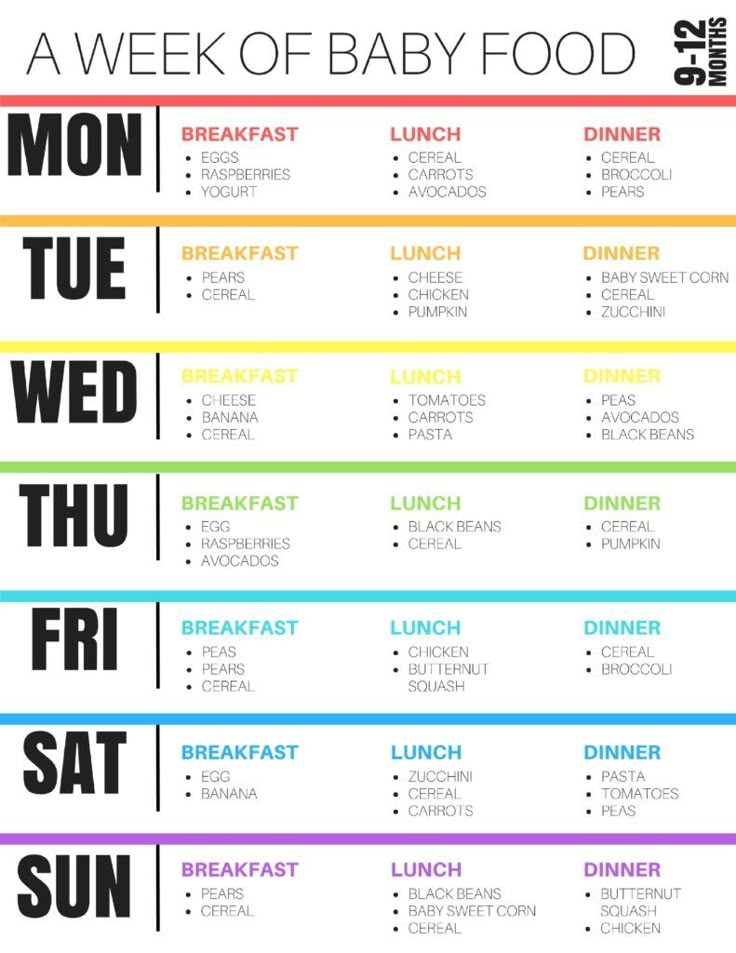 So consult a pediatrician and think carefully about whether to give the baby juices or still prefer mashed potatoes and compotes. An excellent alternative to juices is children's herbal teas. Start introducing your baby to fruits with apples (preferably green varieties), bananas, and pears. The baby's menu is replenished with a new product - meat. Rabbit meat, turkey meat are best suited. Chicken and veal are also considered a good option. Low-fat pulp without streaks is taken. It is boiled or brought to readiness for a couple, then crushed in a blender or meat grinder. Meat with a gradual increase in its quantity is given as part of vegetable purees. Also at 7 months, it's time to give the baby a pumpkin.
So consult a pediatrician and think carefully about whether to give the baby juices or still prefer mashed potatoes and compotes. An excellent alternative to juices is children's herbal teas. Start introducing your baby to fruits with apples (preferably green varieties), bananas, and pears. The baby's menu is replenished with a new product - meat. Rabbit meat, turkey meat are best suited. Chicken and veal are also considered a good option. Low-fat pulp without streaks is taken. It is boiled or brought to readiness for a couple, then crushed in a blender or meat grinder. Meat with a gradual increase in its quantity is given as part of vegetable purees. Also at 7 months, it's time to give the baby a pumpkin.
8 months
An important moment in the introduction of complementary foods during artificial and breastfeeding occurs exactly at 8 months. It's time to give the baby a yolk. Watch the reaction of the body very carefully: if there are any manifestations of allergies. In case of a negative reaction of the body to chicken yolk, exclude it from the menu and try quail. It is best to give this product in the morning feeding from 9 to 11 hours. Along with vegetable and butter, gluten cereals are also introduced: oatmeal, millet, barley, pearl barley. It's time to give your child a taste of light vegetable soups. The components of the dish should be familiar to the child. Do not experiment by introducing dishes into the diet even with one unknown ingredient. Meatballs, boiled or steamed, are added to the meat in the form of mashed potatoes.
In case of a negative reaction of the body to chicken yolk, exclude it from the menu and try quail. It is best to give this product in the morning feeding from 9 to 11 hours. Along with vegetable and butter, gluten cereals are also introduced: oatmeal, millet, barley, pearl barley. It's time to give your child a taste of light vegetable soups. The components of the dish should be familiar to the child. Do not experiment by introducing dishes into the diet even with one unknown ingredient. Meatballs, boiled or steamed, are added to the meat in the form of mashed potatoes.
9 months
At this age, the baby should be introduced to the diet of low-fat fish: pollock, hake, perch, cod. For these purposes, fillets are taken and steamed, stewed or boiled. For the first time, fish are given in very small quantities. Start with once a week, gradually increasing to two. Remember that either fish or meat is given on the same day, without mixing these 2 products. If at the age of 8 months there were no prunes on the menu of the child, it's time to fix it. Dried fruit compote is also an excellent option, which at first is best diluted with water. However, you definitely shouldn’t get carried away with dried apricots, it’s better to wait until the baby reaches the age of one.
Dried fruit compote is also an excellent option, which at first is best diluted with water. However, you definitely shouldn’t get carried away with dried apricots, it’s better to wait until the baby reaches the age of one.
Months 10–12
The diet typical for this period is characterized by an increase in portions to their maximum values indicated in the scheme. Also, it is at this age that the last feeding is gradually replaced by milk or kefir.
Now that you've come across a set of essential recommendations, you're ready to start weaning. Once again, consult with a specialist, be patient, not forgetting to listen to the baby's body. We are confident that you will succeed. The main thing here, as in any other business, is a positive attitude. It all depends on you and your desire to raise a healthy and happy baby with competent eating behavior. Don't stop if you fail and don't get frustrated if things don't go according to plan. Everything will definitely work out.


 This will require pasteurized milk 2.5% fat and sourdough. After the milk turns sour, it is placed in a water bath and heated over low heat until the whey leaves. Then it remains only to drain the liquid through a colander or gauze and grind the resulting curd to make it more tender.
This will require pasteurized milk 2.5% fat and sourdough. After the milk turns sour, it is placed in a water bath and heated over low heat until the whey leaves. Then it remains only to drain the liquid through a colander or gauze and grind the resulting curd to make it more tender. 





